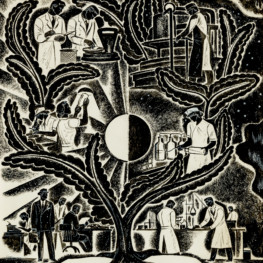Dale Nichols
1904-1995
Born in David City, Nebraska, Dale Nichols began painting around the age of twenty-five. In addition to studying in Vienna under Joseph Binder, a well-known commercial designer, his academic training included coursework at the Chicago Academy of Fine Arts and the Art Institute of Chicago. By the late 1930s he had gained prominence as a painter and an illustrator, exhibiting regularly in New York City and the Midwest, and was awarded a full professorship at the University of Illinois. In 1935, he published a treatise of his artistic theories entitled A Philosophy of Esthetics, which amongst other things advocated raising the standards of art in illustrations and advertisements.
Primarily known for his picturesque landscapes of rural houses and farms, Nichols also painted a number of exotic genre scenes after visiting Guatemala in the 1960s. Inspired by the lushness of the landscape and the country’s ancient heritage, the artist depicted indigenous figures going about their daily lives amongst Mayan ruins, tropical foliage and waterfalls. In general, these works feature a warmer, more muted palette than Nichols’ trademark paintings.
Infused with a distinctly mid-western sensibility, the artist’s modern precisionist painting style updated the landscape genre. Using areas of flat and highly saturated colors, similar in style to the contemporaneous work of Charles Sheeler, Nichols created endearing scenes of rural life. Within the vast expanses of countryside, he often inserted delightful vignettes of human activity, such as farmers gathering the harvest in the field or children running to greet an arriving sleigh, which served to impart an air of nostalgia to the compositions.

